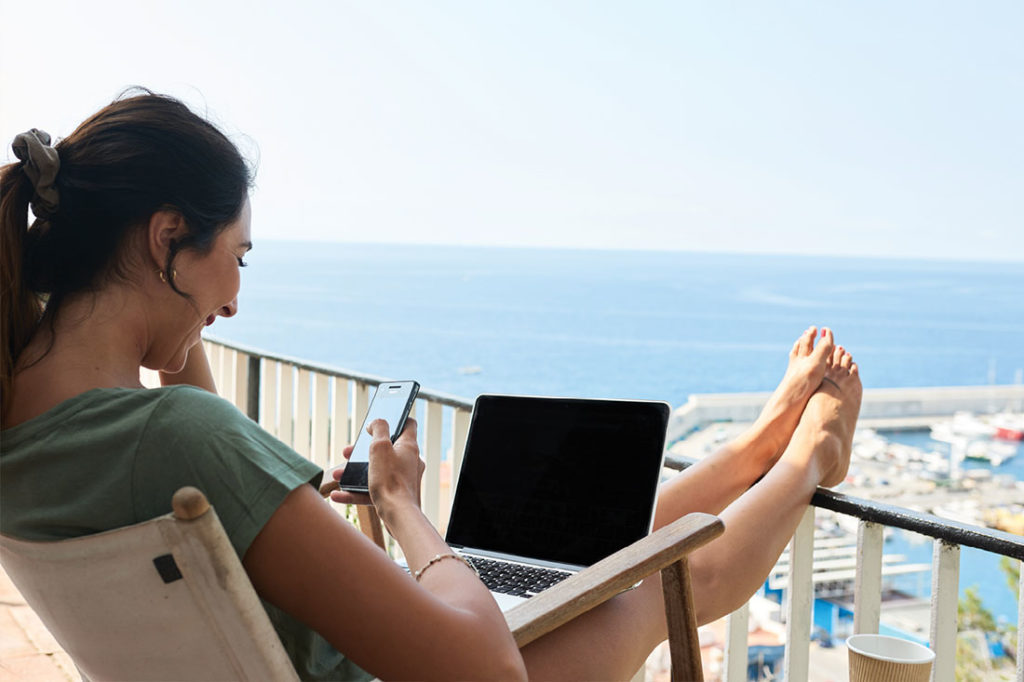Unprecedented times. Uncertain times.
You might even say, with a pandemic raging, these are scary times.
But if you’ve spent these fill-in-the-blank times working from home, you probably wouldn’t say you’ve missed your commute. COVID-19 has forced an unprecedented number of people to work from home, perhaps for the first ongoing period of their lives. Out of this unforeseeable negative came many positive reactions from both employee and employer: increased productivity, more time with partners and children, schedule flexibility… the list goes on. Many companies even began implementing permanent work-from-home allowances. But for a growing number of people, working from home is only the first step.
What if you could work from anywhere in the world?
According to a report by MBO Partners, 4.8 million people had already ditched the white-picket-fence dream to become digital nomads and nomadic solopreneurs by 2018. With nothing but a bag and a loose itinerary, these freedom-chasers move about the world at their own pace and whim, exploring once-in-a-lifetime destinations while building businesses from their laptops.
After beginning my career as an editor at SUCCESS, I began freelancing and joined this movement with my long-time boyfriend three years ago. Since then, we’ve learned how to make spicy red curry in Koh Samui, Thailand, watched the sunrise from the top of Haleakala on Hawaii’s Big Island, and gone waterfall-hunting in the Huasteca region of San Luis Potosi, Mexico. It’s not an easy life, and we’ve made plenty of missteps along the way, but every new experience confirms that our decision was the right one for us.
And with ever-improving technology and 17 million people reporting a desire to become digital nomads, it’s a trend that shows few signs of slowing. If you’re considering striking out on the nomadic path, or you just want a glimpse into the lifestyle, keep reading. We’ve rounded up some of the best tips, tricks, and tools from those who have walked the walk.
1. Build mini routines.
Nomadism is appealing because of its inherent freedom and overall rejection of routine. Today you might learn how to surf in Waikiki; next month you might take a pasta-making class in Bologna. But with this inherent freedom comes a sense of consistent chaos. Plans change; visas are rejected; a new client needs a rushed project. To avoid unnecessary stress (and unhappy clients), build mini routines into your day. For example, if you like to stretch and journal every morning, don’t let a travel day stop that. Stretch in the airport on a layover and journal on the plane. This adaptability allows you to stick to the core of your routine even if it looks a little different day to day.
2. Learn the local transportation culture.
I would never plan a multi-state trip in the U.S. by bus or train. The American bus system is sparse, and train tickets often cost as much if not more than plane tickets. Before visiting a new place, research the local transportation culture. For example, in Thailand, a songthaew or motorbike taxi is much cheaper and easier than a traditional taxi. Mexico has a thriving, nationwide bus system. The buses are cheap, safe, and more luxurious—we’re talking recliners—than planes.
3. Choose your location wisely.
Choosing a country or even a city can be daunting, especially if you’re looking at a longer stay. Your ideal spot will depend on your preferences, but here are some questions to ask yourself when planning your next (or first) destination:
- Can I afford the cost of living?
- Will the language barrier inhibit me from important tasks?
- Does it have the things I enjoy, such as a beach, nature hikes or a thriving digital nomad community?
- What is at the top of my list to see or do while I’m there?
- How much will it cost to get there?
- What’s the weather like this time of year?
- Is it prime tourist season? Am I willing to pay the increased costs and deal with the crowds?
- Does this time zone fit in with my clients’ schedules?
Add to this until you have a checklist of sorts, which can act as your guide. Don’t forget to consider the visa logistics, as five-year nomad Daniel Rusteen, owner of OptimizeMyBnb.com, learned the hard way: “A 30-day visa includes the day of arrival. I overstayed my visa in three countries by either not knowing or counting days wrong.”
4. Expect the unexpected.
Travel never, ever, ever goes as planned. When traveling is your life, you’ll quickly learn that your beautiful itinerary doesn’t account for, well, life. Give yourself grace, especially on travel days. Also, allow yourself the freedom to change your itinerary on a whim because you love a place more than you expected—or the opposite.
“When you travel, if you expect perfection, you will never find it,” says five-year nomad Mag Boron, founder and CEO of Pangian, a digital remote-work community. “Flights get canceled; trains get delayed; unpredictable weather can reshuffle your entire travel itinerary, and yet—the most magical moments happen in those exact moments if we only have the courage to see it… All of sudden, a rainstorm makes us stop at a small, unassuming cafe in the middle of Istanbul only to find the most delicious kunefe there is.”
5. Pick your pace.
During a stint in Mexico, I planned an itinerary of 14 cities in 60 days. We saw incredible sights, but the whole trip was a blur. By the end, we were exhausted, irritable, and ready for rest. It takes some time to find the right pace of travel that works for you. For us, it depends on the location, but typically a month is our minimum. It allows us to rest, restore some routine, and really experience the local culture.
“The issue with [quick travel] is every time I moved to another city or region, it would cost me at least a day of travel, and then I would get there and mostly hang out in my hotel room working,” says Michael Alexis, the CEO of TeamBuilding. com and a digital nomad of nearly nine years. “Now I prefer long-term stays in destinations that I love. These long-term stays provide stability and familiarity that will support you as you navigate the complexity of building a business.”
6. Find your social entry point.
I’m an introvert. I have trouble walking into a room of strangers and introducing myself. No matter your personality, try finding a comfortable and natural social entry point to make new connections. For us, it’s beach volleyball. It’s easy to find some pick-up games, and we always meet people from around the world that turn into connections we maintain long after we leave.
When we first hit the road, I really worried about not having deep or connected relationships,” says Julie Bennett, a six-year full-time RVer and founder of RVLove.com. “But what I have found is that it’s actually been easier to have more meaningful conversations with others we meet—there is mutual respect and an understanding that we’ve each stepped off the treadmill of life to live the RV life.”
7. Blaze your own trail.
Digital nomad resources abound. You can find everything from social media groups to in-person meet-up events, books, conferences—even a dedicated nomad cruise. If you want to use a tried-and-true itinerary or game plan, feel free. But don’t be afraid to venture out on your own. Some of our least-favorite locations and activities were those recommended by others; many of the favorites were discovered by accident.
8. Stay organized.
Without a list, I know every item of clothing that goes in my bag. I know how many pairs of shorts I can roll into a ball before it busts the seams on a packing cube. If a travel day is upcoming, I have the departure times and gate numbers memorized. Efficiency comes with time and practice. In the beginning, consider keeping an itemized inventory and use organization apps to keep you on track, both while traveling and during work.
“The most surprising aspect of the entrepreneurial nomad life is how organized you become; you will literally learn to pack a mobile office effortlessly, the way moms expertly pack the whole house for a family outing,” says six-year nomad Sophie Bowman, CEO and co-founder of Brand Branding, LLC and BusinessOwnerSociety.com. “Their magic bags hold everything you didn’t know you’d need from baby wipes and hand sanitizer to never-ending snacks and allergy meds.”
9. Carve out alone time.
As one-half of a traveling couple, alone time is hard to come by. We inevitably get on each other’s nerves and don’t realize the need for space until an argument breaks out. Choosing accommodations with separate spaces can help mitigate that stress, but it’s crucial to designate time to be truly alone. Creativity is key here. One of you can go to the beach to read while the other gets some relaxation at home. I’m a morning person, so I get most of my solitary time then. Make it work for you.
10. Know your limits.
I’m a recovering itinerary-stuffer. Each new location brings a plethora of activities and sightseeing and events. I want to see and do it all. This excitement usually comes at the price of my mental and emotional well-being—my mostly introverted social battery is limited. Don’t ask too much of yourself and accept that you won’t see everything. In fact, accepting that simple fact gives you the freedom to savor the things you do get to see.
For the time being, as the world continues its effort to untangle from COVID-19, traveling like this may seem like a fantasy. We’ve been sidelined ourselves. But the day will come that this is once again a safe and workable lifestyle, if you want it to pursue it.
Maybe I’ll see you on a volleyball court somewhere.

Portable bag scale –
Unless you’re an ultralight packer, you need this.
Noise-canceling headphones –
Planes, buses, trains, loud coffee shops, snoring partners….
Portable battery pack –
Ever tried navigating to your hotel with a dead phone and a language barrier?
Water thermos –
Long travel days can dehydrate you quickly.
Minimalist day bag –
Opt for one that folds up or attaches to your larger bag when not in use.
Local SIM card or international data plan –
Wi-Fi isn’t a guarantee. Be prepared.
Sleep mask, small pillow and travel blanket –
These things are rarely provided during domestic travel. They can also come in handy at an under-equipped hotel or apartment.

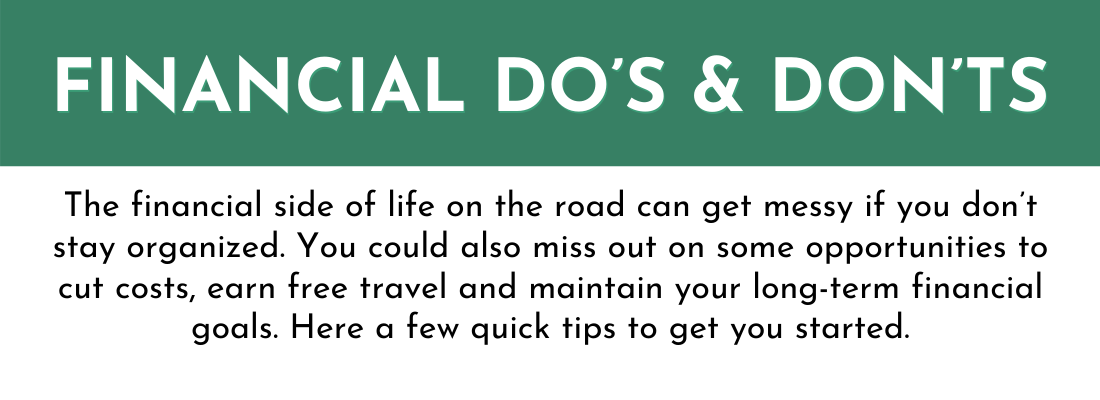
DO make a budget and stick to it.
It’s easy to get carried away in a new place, especially if the cost of living is not what you’re used to. Create a detailed budget that includes those sneaky costs, like local transportation and tourism jaunts.
DO play the travel rewards game.
At least 80 percent of your daily costs are considered travel by card merchants. Don’t let free points and miles go uncollected. Consider opening a travel credit card to earn rewards, cashback or free future travel. Bonus: Many of those cards come with premier perks like flight upgrades and airport lounge access, which can easily offset the card’s annual cost.
DON’T eat at restaurants in the tourist zone.
The food is rarely as good and always three times the price. Stray from the main strip and find some local restaurants. You’ll learn more about the culture while saving money and eating some really good food.
DON’T rely on Wi-Fi.
If you’re in one place for a while, consider buying a local SIM card with a monthly data plan. It’s often significantly cheaper than purchasing an international data plan through your service provider.
DO negotiate.
Bartering is expected if not encouraged in many cultures that enjoy the social aspect of negotiation. Embrace it and have a little fun while saving money.
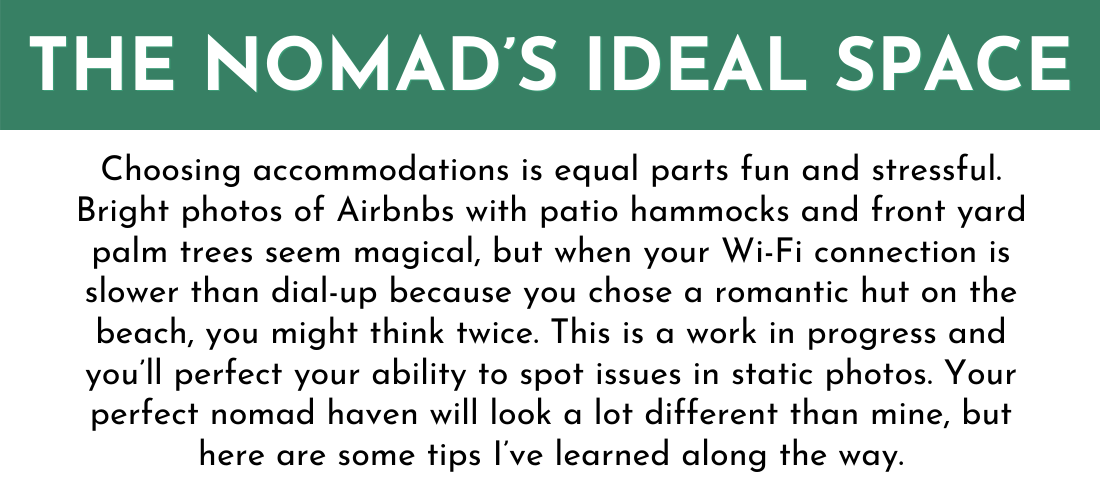
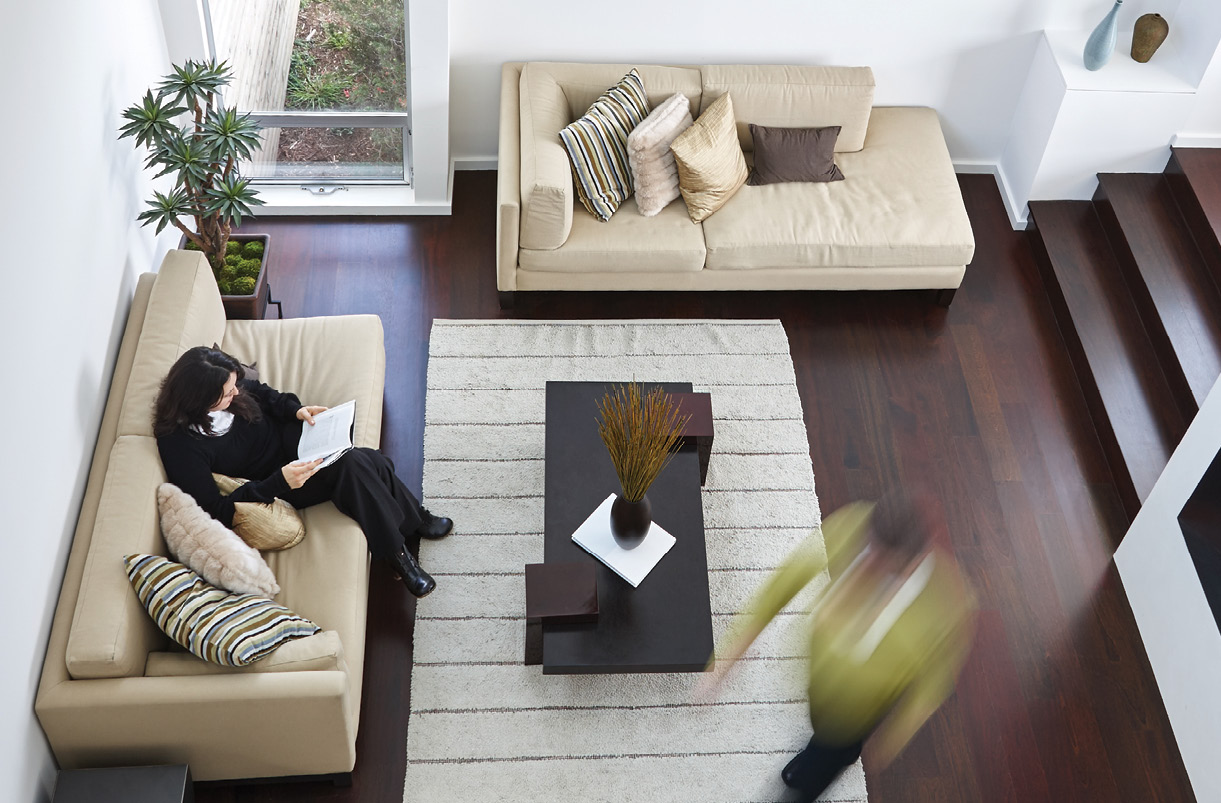
Wi-Fi –
This sounds like a no-brainer, but many developing countries lack the kind of speed you might be used to.
Kitchen –
Cooking from home can save you money and help the place feel more like home.
Separate living and sleeping spaces –
If you’re staying in one place for a long time, these separate spaces ensure you have alone time and aren’t working from a bed every day, which is draining.
Minimize noise –
Research the neighborhood beforehand and read reviews. Is there construction? Is the infamous party hostel two doors down? These factors can greatly impact your work time.
Location –
Sometimes moving even one block away from the main tourist strip can minimize cost and noise. Bonus: These local neighborhoods typically have the best (and cheapest) food options.
Airflow and light –
This is your office. If it doesn’t have air conditioning, look for windows or fans. Ensure there is enough natural or artificial light to work comfortably.
Good bedding –
You can’t do good work without good rest. Read reviews; someone always mentions the quality of the mattress and bedding.
Workspace –
You’ll rarely find the gift of a quality desk, but a sturdy kitchen table and comfortable chair should do the trick.
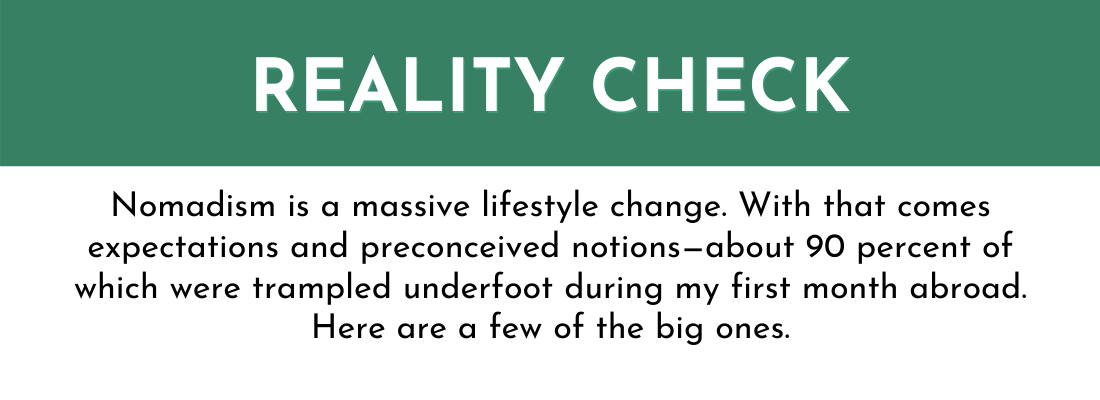
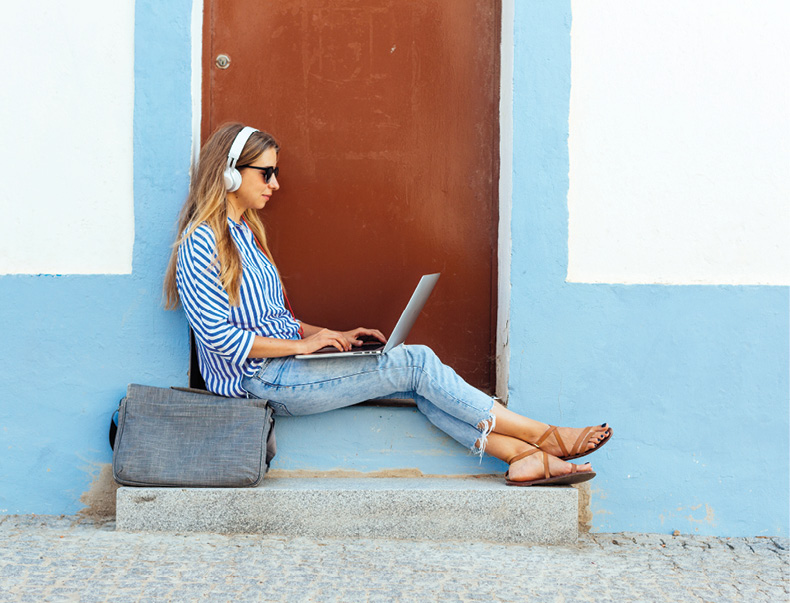
Home is redefined –
The ebb and flow of loneliness can be difficult. What I didn’t expect was a redefining of my concept of home. A little incense and everything-in-its-place brings me home-like feels, even during quick weeklong hotel stays.
Little costs add up –
ATM fees, exchange fees, corner store snacks, night market finds… they all add up. This is where a daily budget—and fee-free debit cards—can come in handy.
You do not work on an actual beach –
Those dreamy photos of feet in the sand, fresh smoothie by your side, and miles of ocean as a backdrop are certainly enticing, but it’s rarely realistic. Reality? Sand in your USB port, sweaty legs from your overheating laptop and loud tourists looking at you like a lunatic.
This is not a permanent vacation –
There is no downplaying this one: The nomad life is exciting. There is a perpetual newness that can be addicting—and distracting.
“Be prepared to struggle with self-organization and self-discipline to work in the beginning,” says Rhys Black, the founder and CEO of Delocate and a nomad for almost three years. “Most new [digital nomads] I meet barely get any work done because they treat it like a holiday.”
You never need everything in your bag –
I’m talking to you, overpackers. I once traveled with a 3-ounce bottle of aloe vera—just in case–for more than four months without touching it. Everything in your bag should be multi-purpose.
“The average household has something like 300,000 items,” says seven-year RV and sailboat nomad Michelle Schroeder-Gardner, founder of MakingSenseofCents.com. “You probably don’t need most of it.”
This article originally appeared in the November/December 2020 issue of SUCCESS magazine.
Main photo by Guille Faingold/Stocksy United



